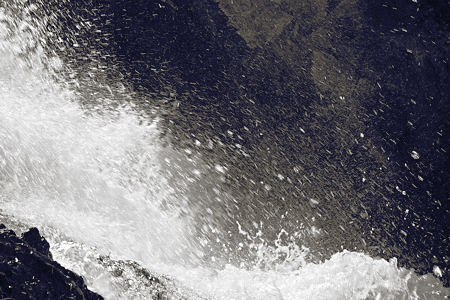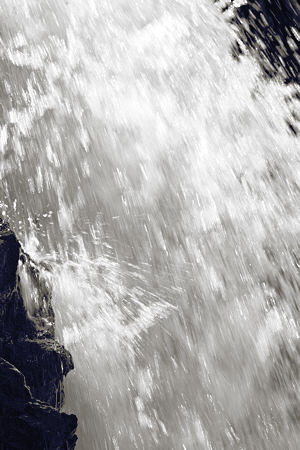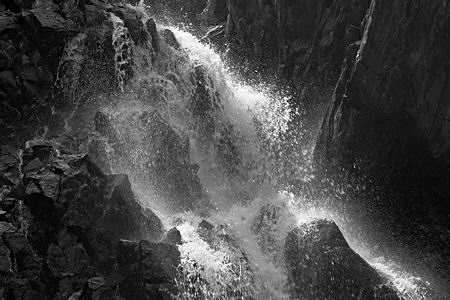
I could be accused of being stuck on my waterfall project lately, but my excuse is that it seems to connect to various other recent posts and comments. Anyway, it’s the work that I’m closest to at the moment, so it makes sense to write about it while it’s fresh. Fresh enough that the ideas are still churning around without order, which in truth is how I like it. I’m inclined by nature to let things ferment in their untidiness, not attempting to resolve or define, hoping/knowing that that will happen on its own eventually.
So this post is partly a record of the connection between concepts and execution, between thinking about the photographs and making them. In the present case, this is a pretty loose and interactive connection, perhaps similar to David’s “chickens, then eggs, then more chickens…” or Leslie’s “dialogue with the idea going back and forth with the making in a pretty comfortable way.” Karl also has been considering the role of concept in art, and I think his question, “Is art something we make, or discover?” is about the same thing. In other words, do we create from a concept or learn by doing? The answer, of course, is that both go on at once, but how it plays out is always different, even for me alone on this single project.
My personal questions involve the roles of abstraction and representation in my work, and, more recently, whether the notion of the sublime applies to or illuminates what I’m doing. Or as June put it concisely, how to “express the sensation of the sublime through photographs that work as abstract art.” I’ve been drifting towards a formulation that the overwhelmingness and the primality of the sublime fit best with binary oppositions (yin/yang?), like strong dark and light shapes of rock and water in most of my waterfalls so far. That rock and water are elemental in themselves makes it all the easier for them to carry connotations of hard/soft, implacable/yielding, harsh/gentle, perhaps even more abstract ideas like death/life. However, only and always binary is too simplistic and single-minded, and increasingly I include other elements like a plant, the sky, a background forest.
One thing is clear: a number of ideas are going through my head at once while making these waterfall photographs, and by no means can a single one or the series be considered an expression of a simple concept or message. Perhaps I could try to do that if I wished, but I see no point. Despite the multiple ambiguity, it’s equally clear that what I’m thinking influences the way the photographs are made, and it seems fair to say the photographs are, in part anyway, “about” the ideas.
Last week Leslie and June advised me to “mess it up” and “stop composing so carefully,” and I thought they might like to see the resulting literal chaos. I haven’t set the camera on timer and thrown it up in the air, but I have spent much of my time looking at scenes that are random, changing moment to moment, denying the possibility of exact composition (though they still allow some measure of framing). This is not Surrealism’s plumbing of the subconscious through “automatic” creation, because the source of the randomness is not within me, but in the chaotic flow of the stream. On the other hand, by selecting from the resulting photographs, is there not a possibility for the subconscious to find expression? Obviously, the selection is also conscious, but I’m sure there’s more to it than merely conscious decisions on criteria I’m aware of. The factor of selection would, however, disappear if I were to use all of the images captured. Perhaps I’ll get to that in a future post; suffice it to say I’m thinking of a theme: air as palimpsest.

I had been thinking of the images more in terms of kinds of shapes, but comments a few weeks ago led me also to consider the aspect of motion. I was interested in my perception of the movement in the water, and how it compared with what the camera captured. Last week, I cited Arthur Danto’s remark that Clifford Ross’s wave photographs show far more chaotic detail in a wave than can be apprehended in the flux of actual experience, and I noted that this reminded me of waterfalls, though I was thinking then in a general way: I hadn’t really considered how I perceive, as immediately as possible, the waterfall when it’s there before me. Putting it to the test this time, I noticed I was indeed seeing the flying water as streaks, much as represented in the first image above (but not as the soft, smooth shapes left by a longer exposure). This impression was especially strong where droplets were brightest in the sun (or against dark rock), and I could follow a small constellation of streaks as they arced out and down. (In retrospect, I felt a fleeting attachment to those flying, bright points like Jay’s to a distant airplane.) However, in attending to such a constellation, I had only a background sense of the whole, and I have to agree with Danto that part of the pleasure of the photographic image is in the leisurely way in which one can explore the whole, instantaneous form that is ungraspable.
The description just given sounds cool and analytical, but becoming more aware of my perception only enhanced the “visceral” (June’s word) experience of the dynamism and power of the waterfall. I literally felt it in my gut. That was partly a feeling of connection to the phenomenon, so close at hand, and partly the stereotypically sublime tingle of fear, quite appropriate in this case, where a disoriented step could lead to extremely unpleasant consequences.
For completeness I should say that photographs like the two shown so far were not the only ones I took. Below is one that might be closer to a Hudson School sublime, though it tries to locate that feeling in a more intimate landscape, rather than a grand, sweeping one. In that regard it’s intermediate between the wide landscape and the in-your-face details shown so far.

So that’s my progress report. No doubt the new approach, and others not shown, will be modified in future. But I like the latest for its raw energy if nothing else. How about you?

I was interested in my perception of the movement in the water, and how it compared with what the camera captured.
Steve, the way you are representing motion so far is by freezing one moment out of many, and letting motion-blur convey the notion that things are moving too fast to capture. That is very effective. But there are other ways.
Another way that we perceive motion is by change from one moment to the next. Have you considered showing sequences of photos of these waterfalls? If the camera were locked off, what you’d see is the movement of the water from frame to frame. Probably more effective in closeup than in a long shot.
David,
Exactly what I want to do. The sequence of stills, I find, is much more compelling than a continuous video. It makes possible the palimpsest concept of (self-)erasing, re-writing, erasing, re-writing, … You don’t get this with side-by-side images, either, because the eye cannot compare them and grasp the changes easily. I’m hoping to make a display in the next week or two which I can put on my web site, if the blog won’t handle it.
That said, I also like the shapes in the individual stills. But it does cry out for some other way of representing movement.
Steve:
I certainly like the last shot. Was any further processing done, or is that straight out of the camera?
An interesting question is coming into focus here: is there a particular mix of blur and detail that might constitute the best representation of a waterfall? I’m put in mind of a time -not that long ago – when lasers bouncing off mirrors set about the urban landscape were quite the thing. It was found that the best color was a kind of blue that said “city” the way that a smoky sax can in the right hands.
But it all comes down to circumstance I suppose. That “Canyon Dreams” video to which I may have referred – where the Grand Canyon performs to a Tangerine Dream soundtrack – has a lot of falling water. It is taken at different speeds, perspectives and times of day, giving very different results. In the case of the image in question,the huge rocky terrain in which you tend to work demands a representation of all of the energy being let loose in that torrent. I don’t believe that a time-lapse effect with everything reduced to a diffuse creaminess would have the right effect. But in the case of the little chute-like cascades that we have around here, hey.
That said, the most evocative image for me is a narrow striated notch canyon evoking episodes of great watery violence, and on its floor is a little tame rivulet in gentle pursuit among the rocks.
Jay,
I always process photos “manually,” i.e. I never use a program that processes automatically. However, I did no unusual or even local adjustments on this one, though I probably would if I were to print it. When viewed “untouched” it already looks essentially as presented, even before converting to black and white.
In a 19th century painting, the bright light from above would be taken as coming from the Architect of Nature.
The amount of blur and detail, and where they occur in the frame, are major variables I am playing with in representing the waterfalls. I don’t think any particular choice can be called best, but they certainly lead to photographs having different impressions on the viewer. There are subtle points like how much of the blur indicates directional motion vs. out-of-focus location, and how the blur varies over the frame. I still have lots ot play and learn with!
I haven’t seen “Canyon Dreams,” but it sounds like I should. I also have not yet been to a real slot canyon, despite several trips to Utah. They do make gorgeous and evocative images, as you say.
Steve,
I have no time, so want to say quickly that the last photo really caught me. It’s truly abstract but it also reminds me of something out of the renaissance.
I haven’t read Jay’s comment yet — nor your response. Later….
Steve,
I really like these, esp the first two, actually, as they seem incredibly spontaneous and dynamic. I’d be tempted to keep the camera moving as I took pictures of movement! Of course that would end up in a huge blur. What a mess I would make :)
I like the idea of the sequence of stills strung together and could also see these printed very large. Like Jay, I think of video, like Bill Viola’s fire/water piece – that’s not the name – one of my favorite museum experiences ever. Have you ever played with printing stills from video? Not as final products, but as ways to think about your work perhaps. PLaying with a new piece of equipment could help you see something from a different perspective.
Steve and Leslie:
Funny you should mention Viola. The very same person came to my mind as I pondered this. But I’m not sure why.
Thanks Leslie and Jay for the lead on Viola, it looks like I can follow up at the local library. I’m glad the sense of movement is suggesting video; I also was reminded of fire/lava looking at some of the images, especially when viewed in sequence.
Leslie, you do push mess to the limit! The effect of moving the camera is easy to replicate in post-processing (e.g. Photoshop), so I didn’t bother with it on location, but I haven’t yet experimented with that. I do have a series of water alone without the still reference point of the rocks. They do make a pleasing abstract design, but I found I liked the touchpoint with reality and the sense of energy lent by the contrast with a corner of rock.
You definitely succeed in capturing the Sublime in that third photograph.